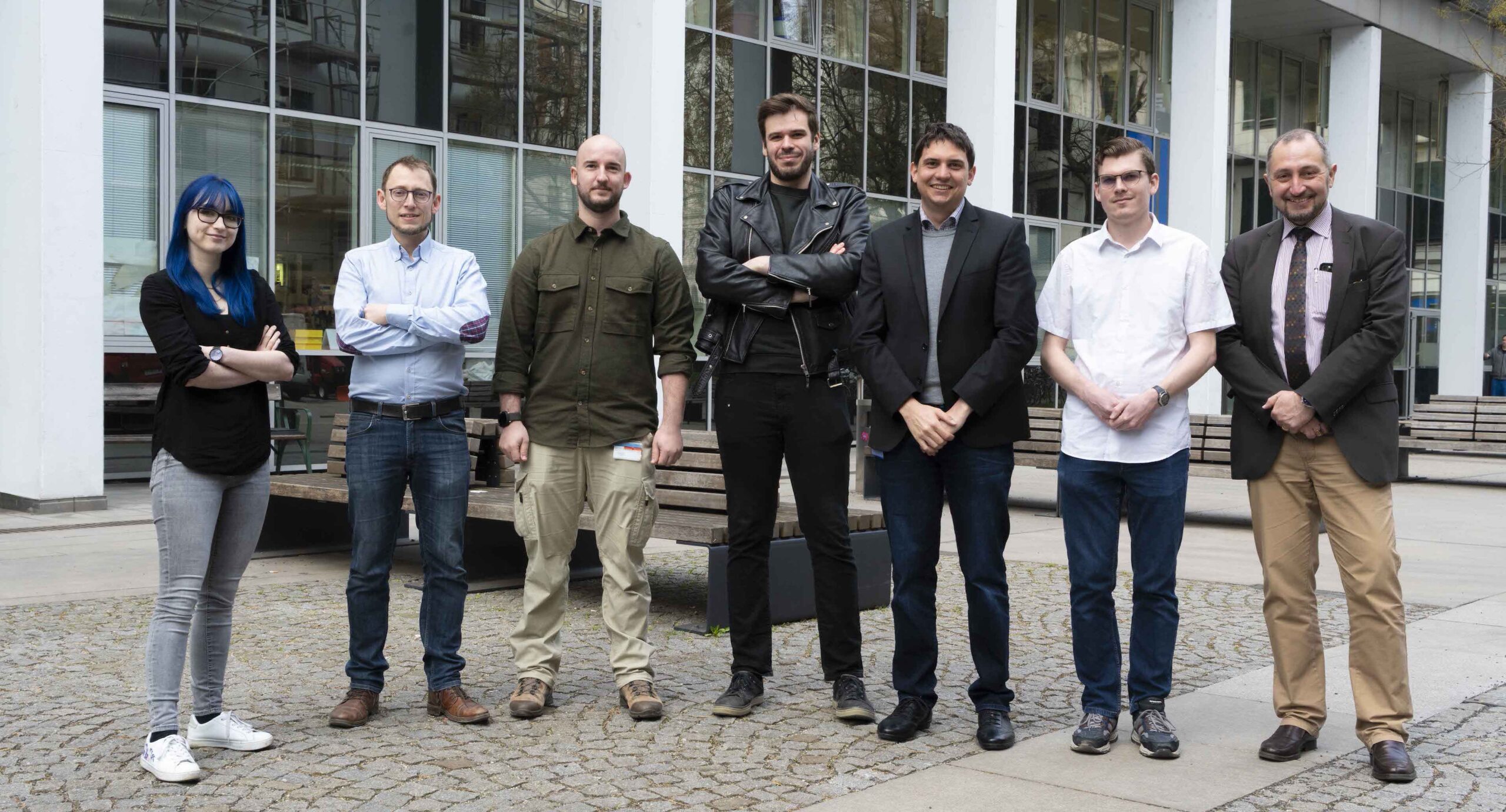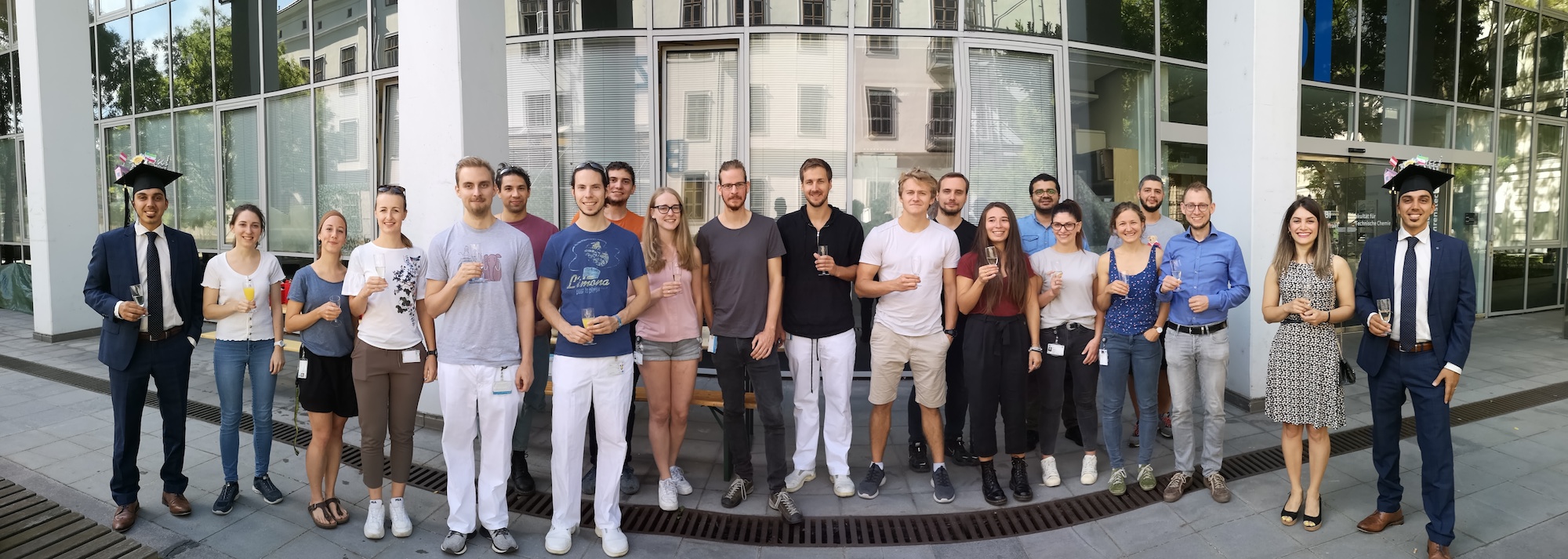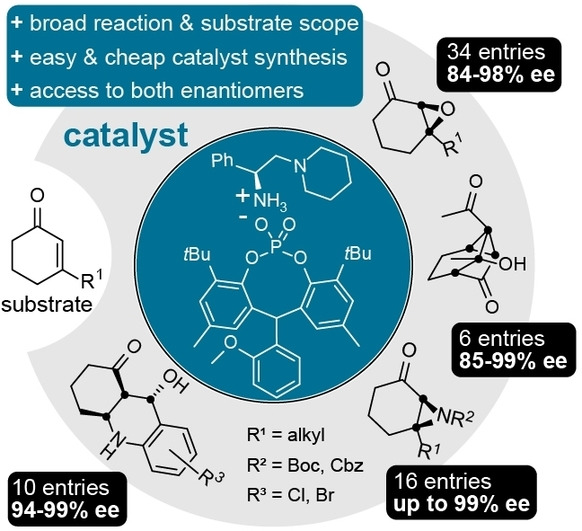Research Lab - Christian Stanetty
Stanetty Lab News
Christian Stanetty received his basic chemistry education at the TU-Wien (Austria) graduating in 2005 (master level) with a specialisation in organic chemistry. During his diploma thesis conducted at the University of Vienna (Prof. Noe), he developed new methodology for the alcoholic cleavage of aziridines and contributed to the synthesis of a novel [18F]-PET tracer intended for Alzheimer disease. He then joined Prof. Kosma’s group (University of Natural Resources and Life Sciences, Vienna) for his doctoral studies exploring the bioactive potential (e.g. antiviral activities) of glycyrrhizin (a triterpene saponine) derived compounds. For the performance throughout his studies he was awarded to receive his doctorate under the auspices of the Austrian Federal President. Christian stayed on in the group to strengthen his expertise in carbohydrate chemistry preparing phosphorylated oligosaccharides based on L-glycero-D-manno-heptose for immunological studies. In 2013, he was awarded an ‘Erwin Schrödinger Fellowship’ (Austrian Science Fund) allowing him to join the group of Prof. Ian Baxendale at Durham University, UK, to get trained in Flow Chemistry by one of the pioneers in this field. In 2015, he returned to TU Wien and joined the research group of Prof. Marko D. Mihovilovic.

Carmona, Pierre Romain
Pierre earned an engineering degree of chemistry from the European School of Polymer and Materials of Strasbourg (ECPM), France and a Master of Science in polymer engineering from the University of Strasbourg, France. His master thesis was performed in the Department of Chemistry of the University of Oslo, Norway. Then he performed his PhD research fellowship in Material Sciences in the Eva Olsson Group, in the Department of Physics at Chalmers University of Technology, Göteborg, Sweden with collaboration with RISE, Research Institutes of Sweden and AstraZeneca. His doctoral thesis was on the structure evolution of phase-separated EC/HPC films for controlled drug release. He is now a postdoctoral researcher in the institute of applied synthetic chemistry in TU Wien and currently working on biobased flocculants, a green replacement for synthetic polymer.
Keywords:
- Polymer science and Biopolymer
- Chemistry and physics of polymers
- Green chemistry
- Light and Fluorescence Microscopy
- Pharmaceutics and drug delivery systems
- Image analysis
Savic, Viktor (PhD Student)
My research topic´s focus lies in the synthesis of modified and functionalized phosphatidylinositolphosphates (PIPs) for elucidation of peptide assemblies in monoamine transporters. Special attention is directed towards inositol desymmetrization/protection strategies and stereospecific assembly of functionalized diacylglycerols and phosphoramidites.
ORCID: 0000-0002-0018-2882
Keywords:
- peptide assemblies
Kalaus, Hubert (PhD Student)
From starch to wood adhesives: Within the BioSet project I am currently investigating and improving means of enzymatic oxidation of starch working under the supervision of Prof. Mihovilovic and Dr. Stanetty. The goal is to develop a competitive alternative to current chemical solutions which require the use of toxic reagents and are of waste-intensive nature. A close collaboration with industry partners and the interdisciplinary background between biochemistry, electrochemistry and synthetic chemistry provide a very interesting setting for my PhD thesis.
ORCID: 0000-0001-8626-6165
Keywords:
- enzymatic oxidation
- electrochemistry
- wood adhesives
Suster, Christoph (PhD Student)
My research interests lie within the development of methodology for carbohydrate chemistry and NMR analytics. I am involved in projects concerning bacterial sugars (heptoses) and NHC catalysed dehomologation of carbohydrates. After graduating in 2021 I am now doing my PhD under the supervision of Christian Stanetty continuing the project of my master thesis. Besides my main research interests , I spend my time working on several different NMR related topics for external cooperations within academia and industry.
ORCID: 0000-0002-9245-9286
Keywords:
- carbohydrate chemistry
- sugar chemistry
- NMR
Biedermann, Nina (PhD Student)
Keywords:
- phase change materials
- sugar chemistry
- non-natural sugar alcohols
- organoindium chemistry
Scheibelreiter, Verena (PhD Student)
I completed my Master’s degree at TU Wien in 2023. My master thesis explored a catalytic method for starch oxidation.
My PhD research revolves around developing enzymatic deprotection strategies for alkyl ethers of different substrates including carbohydrates, utilizing heme-based proteins. Our goal is to expand the chemical space for this type of transformation, making existing synthesis pathways more sustainable and enabling new synthetic strategies.
ORCID: 0000-0002-8236-9658
Keywords:
- enzymatic oxidation
- sugar chemistry
- green chemistry
- dealkylases
Leonhartsberger, Simon (PhD Student)
During his master thesis, Simon worked on the derivatization of biogenic dyes using bio-retrosynthetic analysis and precursor feeding experiments, followed by their identification via HPLC-MS/MS.
After obtaining his master`s degree in technical chemistry in 2022 he started his PhD under the supervision of Prof. Mihovilovic and Dr. Stanetty. Therein his focus lies within the development of biobased polymeric flocculants as substitutes for synthetic benchmark materials in wastewater treatment.
ORCID: 0000-0002-4927-5676
Keywords:
- waste water treatment
- polysaccharides
- polymer modification
Wutscher, Maximilian (PhD Student)
Keywords:
- biocatalysis
- protein engineering
- dealkylation
Standfest, Christoph (Master Student)
After he obtained his Bachelor’s Degree in chemistry and chemical engineering at Johannes Kepler University Linz in 2020, he moved to Vienna to do his Masters in chemistry at TU Wien. Currently, he is working on his Master Thesis under the supervision of Dr. Stanetty and Prof. Schnürch on synthesis and evaluation of non-natural sugar alcohols as potential phase change materials.
ORCID: 0009-0000-6784-8696
Keywords:
- carbohydrate chemistry
- total synthesis
- phase change materials
- metathesis
Christian Stanetty Projects
Publications in Scientific Journals
The synthesis of higher-carbon sugar alcohols via indium-mediated acyloxyallylation as potential phase change materials
Markus Draskovits, Nina Biedermann, Marko D. Mihovilovic, Michael Schnürch* & Christian Stanetty*
Monatsh Chem 2023
In recent years, sugar alcohols have gained significant attention as organic phase change materials (PCMs) for thermal energy storage due to their comparably high thermal storage densities up to 350 J/g. In a computational study, outstandingly high values of up to ~ 450–500 J/g have been postulated for specific higher-carbon sugar alcohols. These optimized structures feature an even number of carbon atoms in the backbone and a stereochemical configuration in which all hydroxyl groups are in an 1,3-anti-relationship, as found in the natural hexitol D-mannitol. However, these manno-configured higher-carbon sugar alcohols have not been experimentally investigated as PCMs yet and described synthetic routes are elaborate multiple steps syntheses. Therefore, we aimed to synthesize sugar alcohols of the manno-series with a concise synthetic protocol based on the indium-mediated acyloxyallylation (IMA) of aldoses. En route the C2-epimers were easily accessible, namely gluco-configured sugar alcohols, bearing one set of hydroxyl groups in a suboptimal 1,3-syn-realtionship. The synthesized compounds were found to possess thermal properties consistent with the predicted values, and the “perfect” higher-carbon sugar alcohol with eight carbon atoms was found to have indeed an outstanding high latent heat of fusion of ~ 380 J/g with a melting point of 260 °C.
Phytosiderophore pathway response in barley exposed to iron, zinc or copper starvation
David Aleksza, Andreea Spiridon, Mika Tarkka, Marie-Theres Hauser, Stephan Hann, Tim Causon, Nicolas Kratena, Christian Stanetty, Timothy S. George, Joanne Russell, Eva Oburger*
Plant Science 339, 2024, 111919
Total synthesis of [13C2]-labeled phytosiderophores of the mugineic and avenic acid families
Surveying the mugineic acid family: Ion mobility – quadrupole time-of-flight mass spectrometry (IM-QTOFMS) characterization and tandem mass spectrometry (LC-ESI-MS/MS) quantification of all eight naturally occurring phytosiderophores
Sterically Demanding Flexible Phosphoric Acids for Constructing Efficient and Multi-Purpose Asymmetric Organocatalysts
Fabian Scharinger, Ádám Márk Pálvölgyi, Melanie Weisz, Matthias Weil, Christian Stanetty, Michael Schnürch, Katharina Bica-Schröder*
Angew. Chem. Int. Ed. (2022) 61, e202202189
Herein, we present a novel approach for various asymmetric transformations of cyclic enones. The combination of readily accessible chiral diamines and sterically demanding flexible phosphoric acids resulted in a simple and highly tunable catalyst framework. The careful optimization of the catalyst components led to the identification of a particularly powerful and multi-purpose organocatalyst, which was successfully applied for asymmetric epoxidations, aziridinations, aza-Michael-initiated cyclizations, as well as for a novel Robinson-like Michael-initiated ring closure/aldol cyclization. High catalytic activities and excellent stereocontrol was observed for all four reaction types, indicating the excellent versatility of our catalytic system. Furthermore, a simple change in the diamine’s configuration provided easy access to both product antipodes in all cases.
A new carbohydrate-active oligosaccharide dehydratase is involved in the degradation of ulvan
Marcus Bäumgen, Theresa Dutschei, Daniel Bartosik, Christoph Suster, Lukas Reisky, Nadine Gerlach, Christian Stanetty, Marko D. Mihovilovic, Thomas Schweder, Jan-Hendrik Hehemann, Uwe T. Bornscheuer*
J. Biol. Chem. (2021) 297 (4) 101210
Marine algae catalyze half of all global photosynthetic production of carbohydrates. Owing to their fast growth rates, Ulva spp. rapidly produce substantial amounts of carbohydrate-rich biomass and represent an emerging renewable energy and carbon resource. Their major cell wall polysaccharide is the anionic carbohydrate ulvan. Here, we describe a new enzymatic degradation pathway of the marine bacterium Formosa agariphila for ulvan oligosaccharides involving unsaturated uronic acid at the nonreducing end linked to rhamnose-3-sulfate and glucuronic or iduronic acid (Δ-Rha3S-GlcA/IdoA-Rha3S). Notably, we discovered a new dehydratase (P29_PDnc) acting on the nonreducing end of ulvan oligosaccharides, i.e., GlcA/IdoA-Rha3S, forming the aforementioned unsaturated uronic acid residue. This residue represents the substrate for GH105 glycoside hydrolases, which complements the enzymatic degradation pathway including one ulvan lyase, one multimodular sulfatase, three glycoside hydrolases, and the dehydratase P29_PDnc, the latter being described for the first time. Our research thus shows that the oligosaccharide dehydratase is involved in the degradation of carboxylated polysaccharides into monosaccharides.
A Kinetic Photometric Assay for the Quantification of the Open-Chain Content of Aldoses
H. Kalaus, A. Reichetseder, V. Scheibelreiter, F. Rudroff, C. Stanetty*, M.D. Mihovilovic
European Journal of Organic Chemistry, (2021), 18; S. 2589 – 2593.
Efficient Acylation of Sugars and Oligosaccharides in Aqueous Environment Using Engineered Acyltransferases
Godehard, Simon P.; Mueller, Henrik; Badenhorst, Christoffel P. S.; Stanetty, Christian; Suster, Christoph; Mihovilovic, Marko D.; Bornscheuer, Uwe T.*
ACS Catalysis (2021), 11(5), 2831-2836.
A major challenge for the enzymatic synthesis of sugar esters is the low solubility of sugars in anhydrous, often toxic, organic solvents. We overcame this limitation by using acyltransferases for efficient acetylation of sugars in water. Selective 6-O-acetylation of glucose, maltose, and maltotriose with conversions of up to 78% was achieved within 15 min using engineered acyltransferases (4 μM). Moreover, we identified EstA as a promiscuous acyltransferase preferentially acetylating sugars instead of hydrophobic acyl acceptors. This expands the applicability of promiscuous acyltransferases to sugar modifications and contributes to the understanding of how to adapt acyltransferases to hydrophilic substrates.
The role of hydrogen bonding in the incommensurate modulation of myo-inositol camphor ketal
Viktor Savic, Felix Eder, Christian Göb, Marko D. Mihovilovic, Christian Stanetty and Berthold Stögerd*
Acta Crystallographica Section B, 77 (2021), 83 – 92.
myo-Inositol-2,3-D-camphor ketal crystallizes as an incommensurate structure with the C2(0σ2½) superspace group symmetry [σ2 = 0.1486 (3) at 100 K]. The bornane and myo-inositol moieties aggregate in distinct layers extending parallel to (001). The myo-inositol rings are connected by a complex hydrogen-bonding network extending in two dimensions, which is disordered in the basic structure and (mostly) ordered in the actual modulated structure. The domains of definition of the H atoms in internal space were derived by chemical reasoning and modeled with crenel functions. By tracing the hydrogen bonding, distinct chains, which are periodic in the [100] direction, are identified. These chains possess one of two possible orientations with respect to the hydrogen bonding. The incommensurate modulation is characterized by a non-periodic succession of the two chain orientations in the [010] direction. On heating, the σ2-component of the modulation wave vector decreases from σ2 = 0.1486 (3) at 100 K to σ2 = 0.1405 (6) at 430 K, which means that the periodicity of the modulation wave increases. No order–disorder phase transition was evidenced up to the melting point (with decomposition).
A Unified Approach to Phytosiderophore Natural Products
N. Kratena, T. Gökler, L. Maltrovsky, E. Oburger, C. Stanetty*
Chemistry – A European Journal, 26 (2020).
This work reports on the concise total synthesis of eight natural products of the mugineic acid and avenic acid families (phytosiderophores). An innovative „east‐to‐west“ assembly of the trimeric products resulted in a high degree of divergence enabling the formation of the final products in just 10 or 11 steps each with a minimum of overall synthetic effort. Chiral pool starting materials (l‐malic acid, threonines) were employed for the outer building blocks while the middle building blocks were accessed by diastereo‐ and enantioselective methods. A highlight of this work consists in the straightforward preparation of epimeric hydroxyazetidine amino acids, useful building blocks on their own, enabling the first synthesis of 3’’‐hydroxymugineic acid and 3’’‐hydroxy‐2’‐deoxymugineic acid.
Straight Forward and Versatile Differentiation of the L-glycero and D-glycero-D-manno Heptose Scaffold
C. Suster, I. Baxendale, M.D. Mihovilovic, C. Stanetty*
Frontiers in Chemistry, 8 (2020), 625; 7 pages.
Bacterial lipopolysaccharides (LPS) are important bio-medical structures, playing a major role in the interaction with human immune systems. Their core regions, containing multiple units of L–glycero–D–manno heptoses (L,D-heptose), are highly conserved structurally (with O3 and O7 glycosidic bonds), making them an epitope of high interest for the potential development of new antibiotics and vaccines. Research in this field has always been restricted by the limited availability of the parent L,D-heptose as well as its biochemical epimeric precursor D–glycero–D–manno heptose (D,D-heptose). This problem of availability has recently been solved by us, through a rapid and efficient practical synthesis of L,D–manno-heptose peracetate demonstrated at scale. Herein we report an optimized, technically simple and versatile synthetic strategy for the differentiation of both the L–glycero and D–glycero–D–manno heptose scaffolds. Our approach is based on an orthoester methodology for the differentiation of all three positions of the sugar core using a O6, O7-tetraisopropyl disiloxyl (TIPDS) protecting group for the exocyclic positions. Furthermore, the regioselective opening toward 7-OH acceptors (6O-FTIPDS ethers) differentiates the exocyclic diol which has been demonstrated with a broader set of substrates and for both manno-heptoses for the first time.
Methyl glycosides via Fischer glycosylation: translation from batch microwave to continuous flow processing
J. Aronow, C. Stanetty*, I. Baxendale, M.D. Mihovilovic
Monatshefte für Chemie, 150 (2019), 1; 11 – 19.
A continuous flow procedure for the synthesis of methyl glycosides (Fischer glycosylation) of various monosaccharides using a heterogenous catalyst has been developed. In-depth analysis of the isomeric composition was undertaken and high consistency with corresponding results observed under microwave heating was obtained. Even in cases where addition of water was needed to achieve homogeneity—a prerequisite for the flow experiments—no detrimental effect on the conversion was found. The scalability was demonstrated on a model case (mannose) and as part of the target-oriented synthesis of D–glycero–D–manno heptose, both performed on multigram scale.
Intercepted dehomologation of aldoses by N-heterocyclic carbene catalysis – a novel transformation in carbohydrate chemistry
M. Draskovits, H. Kalaus, C. Stanetty*, M.D. Mihovilovic
Chemical Communications, 55 (2019), 81; 12144 – 12147.
The development of an N-heterocyclic carbene (NHC) catalysed intercepted dehomologation of aldoses is reported. The unique selectivity of NHCs for aldehydes is exploited in the complex context of reducing sugars. Examples of strong substrate governance for either intercepted dehomologation or a subsequent redox-lactonisation were identified and mechanistically understood. More importantly, it was shown that catalyst design allowed the tuning of the selectivity of the reaction with structurally unbiased starting materials towards either of the two scenarios.
A marine bacterial enzymatic cascade degrades the algal polysaccharide ulvan
L. Reisky, A. Prechoux, M. Zühlke, M. Bäumgen, C. Robb, N. Gerlach, T. Roret, C. Stanetty, R. Larocque, M. Gurvan, T. Song, S. Markert, F. Unfried, M.D. Mihovilovic, A. Trautwein-Schult, D. Becher, T. Schweder*, U. Bornscheuer*, J. Hehemann*
Nature Chemical Biology, 15 (2019), 803 – 812.
Marine seaweeds increasingly grow into extensive algal blooms, which are detrimental to coastal ecosystems, tourism and aquaculture. However, algal biomass is also emerging as a sustainable raw material for the bioeconomy. The potential exploitation of algae is hindered by our limited knowledge of the microbial pathways—and hence the distinct biochemical functions of the enzymes involved—that convert algal polysaccharides into oligo- and monosaccharides. Understanding these processes would be essential, however, for applications such as the fermentation of algal biomass into bioethanol or other value-added compounds. Here, we describe the metabolic pathway that enables the marine flavobacterium Formosa agariphila to degrade ulvan, the main cell wall polysaccharide of bloom-forming Ulva species. The pathway involves 12 biochemically characterized carbohydrate-active enzymes, including two polysaccharide lyases, three sulfatases and seven glycoside hydrolases that sequentially break down ulvan into fermentable monosaccharides. This way, the enzymes turn a previously unexploited renewable into a valuable and ecologically sustainable bioresource.
Indium- and Zinc-Mediated Acyloxyallylation of Protected and Unprotected Aldotetroses—Revealing a Pronounced Diastereodivergence and a Fundamental Difference in the Performance of the Mediating Metal
M. Draskovits, C. Stanetty*, I. Baxendale, M.D. Mihovilovic
Journal of Organic Chemistry, 83 (2018), 5; 2647 – 2659.
The acyloxyallylation of unprotected aldoses was first demonstrated more than a decade ago as a potentially elegant two-carbon homologation of reducing sugars (upon ozonolysis); however, its application in real case syntheses remained scarce. Following up on such a successful showcase and to answer several pending questions about this attractive transformation, we engaged in an in depth methodological reinvestigation. The epimeric tetroses l-erythrose and d-threose in unprotected and protected form were successfully applied to the indium and also zinc-mediated acyloxyallylation, with the latter being a first for an unprotected sugar. The investigation largely benefited from the choice of these more exotic starting materials as it allowed unambiguous identification/quantification of the hexose-products which are available as authentic reference materials. The observed diastereoselectivities indicate a strong substrate control (stereochemistry at O2), and the influence of the reagent’s structure on the selectivity was investigated in great detail. A strong facial diastereodivergence between related protected and unprotected structures was demonstrated and an unexpected, pronounced principle difference in performance between indium and zinc was revealed.
Biochemical characterization of an ulvan lyase from the marine flavobacterium Formosa agariphila KMM 3901T
L. Reisky, C. Stanetty, M.D. Mihovilovic, T. Schweder, J. Hehemann, U. Bornscheuer*
Applied Microbiology and Biotechnology, 102 (2018), 16; 6987 – 6996.
Carbohydrates are the product of carbon dioxide fixation by algae in the ocean. Their polysaccharides are depolymerized by marine bacteria, with a vast array of carbohydrate-active enzymes. These enzymes are important tools to establish biotechnological processes based on algal biomass. Green tides, which cover coastal areas with huge amounts of algae from the genus Ulva, represent a globally rising problem, but also an opportunity because their biomass could be used in biorefinery processes. One major component of their cell walls is the anionic polysaccharide ulvan for which the enzymatic depolymerization remains largely unknown. Ulvan lyases catalyze the initial depolymerization step of this polysaccharide, but only a few of these enzymes have been described. Here, we report the cloning, overexpression, purification, and detailed biochemical characterization of the endolytic ulvan lyase from Formosa agariphila KMM 3901T which is a member of the polysaccharide lyase family PL28. The identified biochemical parameters of the ulvan lyase reflect adaptation to the temperate ocean where the bacterium was isolated from a macroalgal surface. The NaCl concentration has a high influence on the turnover number of the enzyme and the affinity to ulvan. Divalent cations were shown to be essential for enzyme activity with Ca2+ likely being the native cofactor of the ulvan lyase. This study contributes to the understanding of ulvan lyases, which will be useful for future biorefinery applications of the abundant marine polysaccharide ulvan.
Online quantitative mass spectrometry for the rapid adaptive optimisation of automated flow reactors
N. Holmes, G. Akien, R. Savage, C. Stanetty, I. Baxendale, J. Blacker, B. Taylor, R. Woodward, R. Meadows, R. Bourne*
Reaction Chemistry & Engineering, 1 (2016), 1; 96 – 100.
An automated continuous reactor for the synthesis of organic compounds, which uses online mass spectrometry (MS) for reaction monitoring and product quantification, is presented. Quantitative and rapid MS monitoring was developed and calibrated using HPLC. The amidation of methyl nicotinate with aqueous MeNH2 was optimised using design of experiments and a self-optimisation algorithm approach to produce >93% yield.
Microbial decomposition of 13C- labeled phytosiderophores in the rhizosphere of wheat: Mineralization dynamics and key microbial groups involved
E. Oburger*, B. Gruber, W Wanek, A. Watzinger, C. Stanetty, Y. Schindlegger, S. Hann, W. Schenkeveld, S. Krämer, M. Puschenreiter
Soil Biology and Biochemistry, 98 (2016), 196 – 207.
Being low molecular weight carbon (LMW-C) compounds, phytosiderophores (PS) released by strategy II plants are highly susceptible to microbial decomposition. However, to date very little is known about the fate of PS in soil. Using in-house synthesized 13C4-2′-deoxymugineic acid (DMA), the main PS released by wheat, we investigated DMA mineralization dynamics, including microbial incorporation into phospholipid fatty acids (PLFA), in the wheat rhizosphere and bulk soil of two alkaline and one acidic soil. Half-lives of the intact DMA molecule (3–8 h) as well as of DMA-derived C-compounds (8–38 days) were in the same order of magnitude as those published for other LMW-C compounds like sugars, amino acids and organic acids. Combining mineralization with PLFA data showed that between 40 and 65% of the added DMA was either respired or incorporated into soil microbial biomass after 24 h, with the largest part of total incorporated DMA-13C being recovered in gram negative bacteria. Considering root growth dynamics and that PS are mainly exuded from root tips, the significantly slower mineralization of DMA in bulk soil is of high ecological importance to enhance the Fe scavenging efficiency of PS released into the soil.
Large-Scale Synthesis of Crystalline 1,2,3,4,6,7-Hexa-O-acetyl-L-glycero-#A-D-manno-heptopyranose
C. Stanetty*, I. Baxendale
European Journal of Organic Chemistry, 2015 (2015), 12; 2718 – 2726.
The higher‐carbon sugar L‐glycero‐D‐manno‐heptose is a major constituent of the inner core region of the lipopolysaccharide (LPS) of many Gram‐negative bacteria. All preparative routes used to date require multiple steps, and scalability has been rarely addressed. Here a highly practical synthesis of crystalline 1,2,3,4,6,7‐hexa‐O‐acetyl‐L‐glycero‐α‐D‐manno‐heptopyranose by a simple four‐step sequence starting from L‐lyxose is disclosed. Only two recrystallisations are required and the process was demonstrated on a >100 mmol scale, yielding 41 g of the target compound.

Draskovits, Markus (Postdoc)
Markus graduated at TU Wien in 2016 and started his PhD studies subsequently afterwards. After a short time scientific stay at Durham University, he was able to finish his thesis and defend it in July 2020. He stayed part of the team as postdoctorial researcher until May 2021. His PhD thesis dealt with the activation of the anomeric carbon of reducing sugars either via NHC catalysis or indium mediated acyloxyallylation. In PostDoc project he was preparing natural occurring Phytosiderophores, which are being investigated on their ability to accumulate micronutrients in plant roots (in collaboration with BOKU).
Now Markus made his next career step and joined Takeda Pharma in Vienna
ORCID: 0000-0002-2835-1692
Keywords:
- sugar chemistry
- NHC catalysis
- Phytosiderophores
Kratena, Nicolas
Keywords:
- Total synthesis
- Phytosiderophores
- Steroids
Obleser, Katharina
Keywords:
- enzymatic oxidation
- electrochemistry
- wood adhesives

Christian Stanetty
Senior Scientist Dipl.-Ing. Dr.techn.



















